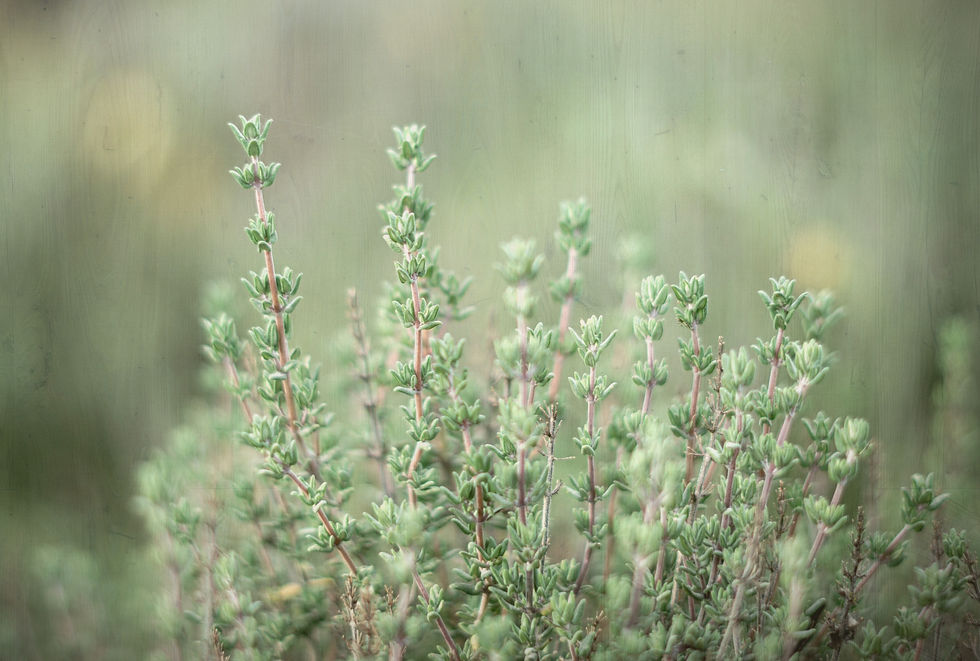Time for Thyme
- Laura Van Horn
- Apr 4, 2024
- 6 min read
When you think about thyme, and the properties of thyme...

When you think about thyme and its properties, it's hard not to appreciate the versatility and benefits this herb brings. Thyme is a common perennial garden herb, often found planted alongside other Mediterranean herbs such as oregano, basil, tarragon, and (sweet) marjoram. These herbs make great garden friends and tasty herb blends. While it may seem delicate with its tiny leaves, thyme can be quite vigorous, even making good ground cover in some varieties.
Belonging to the mint family, thyme emits a delightful aroma that blends minty and earthy notes, accompanied by a complex taste profile of minty, sweet-spicy, and earthy flavors. Its herbal energetics are warming, drying, and toning, contributing to its diverse medicinal properties. Thyme offers a variety of medicinal benefits due to its rich chemical composition, including compounds like thymol, carvacrol, and linalool.
Traditionally used as both a culinary spice and a powerful medicinal herb, thyme boasts antimicrobial properties, making it effective against bacterial and fungal infections, particularly in the respiratory and digestive systems. It's highly effective against cold and flu symptoms, acting as a respiratory antimicrobial and expectorant, while also stimulating appetite and aiding digestion.

Incorporating thyme into your daily routine can not only add flavor to your dishes but also provide numerous health benefits, making it a valuable addition to your herbal arsenal.
Herbs de Provence
A Mediterranean herb blend that pairs well with meats and potato dishes:
4-6 parts dried thyme
4 parts dried savory
4 parts dried (sweet) marjoram
3 parts dried rosemary
1 part dried oregano
1 part dried basil
1 part dried tarragon
pinch of dried lavender
Thyme for Tea
If you are feeling congested and run down from a spastic cough, try this tea:
2 tsp thyme
1-2 tsp sage
1 cinnamon stick
1/2 lemon with peel, sliced, or 1 Tbsp lemon juice
raw honey
Place the thyme, sage, cinnamon, and lemon in a pot with about 2 cups of water, and simmer over low heat for 10-20 minutes. The simmering pot will release potent aromatics to help clear the air. Once you are done steeping, remove the pot from the heat and strain out the herbs. Add honey to taste.
Thieves Vinegar
Similar to fire cider, but using similar herbs of Thieves essential oil blend. Take 1 to 2 Tbsp of this vinegar daily during cold and flu season. Increase to 1 Tbsp every few hours if you feel like you have caught a respiratory bug.
2 parts dried rosemary
2 parts dried thyme
2 parts dried sage
1/2-1 part cinnamon chips or 1 cinnamon stick
1/2-1 part cloves
1/2 part dried lemon peel
1/2 part dried lavender flowers plus or minus the leaves
1/2 part dried rose hips
1/2 part freshly ground black pepper
Raw apple cider vinegar
Place all of the herbs into a mason jar to 1/2 - 2/3 full, then top with the apple cider vinegar. Be sure to use a plastic lid because the vinegar reacts with metal. Label the jar and set aside to macerate for about 4 weeks. Shake the jar daily to assist in the process. After 4 weeks, strain off the solids. Label and date your Thieves vinegar and store it in a cool, dark place. For a more palatable taste, add some raw honey to the finished vinegar. It is best to make a new batch each year.
Herbal Antiseptic Wash
If you or a family member has a wound that can be treated at home, try this antiseptic wound wash recipe. A wound wash is just a tea that is used topically. Feel free to use the ingredients to make a tincture or infuse into witch hazel if you prefer to have a ready-made product on the shelf, just remember that alcohol on wounds as it is painful and can potentially cause some additional tissue damage.
Thyme - antimicrobial, antiseptic, and anti-inflammatory
Lavender - antiseptic, antimicrobial, anti-inflammatory, analgesic, and wound healing
Yarrow - antibacterial, anti-inflammatory, and styptic
Plantain - astringent, antimicrobial, anti-inflammatory, and wound healing
Calendula - antimicrobial, and wound healing
Chamomile - wound healing
Rosemary - antimicrobial
Using whichever of the above herbs, fresh or dried, make a tea by steeping for at least 5 minutes, the longer the steep the stronger the tea/wash. Be sure to fully strain off all solids, and allow to cool to a comfortable temperature before using it to wash the wound. The wound wash tea can be stored in the refrigerator for up to 48 hours.
Thyme Steam
For complaints of sinus congestion, spastic cough, productive coughs, sore throat, or a runny nose from a head cold or allergies, try an herbal steam using thyme. Herbal steams allow you to inhale the aerosolized constituents directly into your respiratory system, providing relief and comfort. They are safe and effective for most individuals who can comfortably sit with the steaming pot.
To prepare a steam, start by bringing a pot of water to a boil on the stovetop. Once boiling, remove it from the heat and place it on a stable surface, such as the kitchen table. Add a handful or two of thyme and any other aromatic herbs you prefer, such as rosemary, lemon peel, pine needles, mint, or basil. Position yourself comfortably over the steaming pot, ensuring your head is at a safe distance. Create a steam tent by placing a towel over your head and the pot, trapping the steam inside. Inhale the aromatic steam for up to 10 minutes, allowing it to provide soothing relief to your respiratory system.
Afterward, leave the pot out to continue releasing the medicinal aromatics into the air, helping to cleanse and freshen the room air. This simple and natural remedy can offer comfort and relief during times of congestion and discomfort.
Thyme Foot Soak
2 Tbsp dried thyme
1 Tbsp dried lavender
1/2 cup of Epsom salt of magnesium chloride flakes
Fill a large bowl, tub, or pot with hot water, making sure it is big enough to fit your feet comfortably. Place the dried thyme and lavender into a muslin tea bag or directly into the water. Allow the herbs to steep in the hot water for several minutes, creating a herbal tea bath for your feet. You can choose to remove the herbs from the water or leave them in while you soak your feet. This herbal foot soakoffers relaxation and has antifungal properties.
Thyme Essential Oil
Thyme's role in the aromatherapy realm parallels that of the herbal realm. Much like the plant itself, which spreads along the ground to shield against moisture loss and protect its surroundings, thyme essential oil takes on a protective role by purifying surfaces and the air, deterring harmful microbes and fungal threats.
Similar to rosemary, thyme produces different chemotypes. These variations, known as chemotypes, occur within the same genus and species of a plant that produce distinct essential oils under different growing conditions. The different chemotypes of thyme are thymol, carvacrol, linalool, thuyanol, and geraniol. Thyme ct linalool and thyme ct thymol are the most commonly available chemotypes of thyme essential oil.
Linalool, also found in lavender, offers gentle benefits for the skin, nervous, and immune systems. Thyme ct linalool essential oil is well suited to be used in a relaxing respiratory blend, as well as wound healing blends. Meanwhile, thymol reduces infection, pain, inflammation, and muscle spasms. Thyme ct thymol essential oil is particularly effective in acute illnesses, and proves beneficial for addressing conditions like colds, flu, arthritis, and sciatica, providing warmth and relief.
Roll-on Relaxing Thyme
2 drops of cedarwood (Juniperus virginiana)
1 drop of frankincense (Boswellia carterii)
1 drop thyme ct linalool
1 roller bottle
jojoba oil
Add the essential oil drops to a 10ml roller bottle, then top off with jojoba oil, or the carrier oil of your choice. Place the roller ball cap on, and be sure to label the bottle. Roll this blend behind your ears and on your wrists up to 5 times per day to bring relaxation as needed.
Thyme Room Spray
9 drops of grapefruit (Citrus paradisi)
4 drops thyme ct linalool (thymus vulgaris linalool)
4 drops balsam fir (Abies balsamea)
100ml victorian blend hyrosol
Affiliate Link Disclosure: Some links on this site are affiliate links. As an Aromatics International Associate, I may earn a small commission from qualifying purchases, at no cost to you. Your support through these links helps keep this site running. |
Thyme for Pain Relief Lotion
2 drops thyme ct thymol (Thymus vulgaris ct thymol)
2 drops juniper berry (Juniperus communis)
6 drops lavender (Lavandula angustifolia)
2 oz unscented lotion base
Add essential oil drops to the unscented lotion base and blend in very well. Use lotion on areas of pain and inflammation one to two times per day as needed.

Keep thyme in your herb garden, kitchen pantry, and essential oil collection so that it will always be right there when you need it. Whether you're looking to add a burst of flavor to your culinary creations or seeking natural remedies for wellness, thyme proves to be a versatile and reliable ally. So, the next time you think of thyme, envision not just a humble herb but a powerhouse of flavor and healing, ready to elevate your dishes and wellness routines alike.







Comments